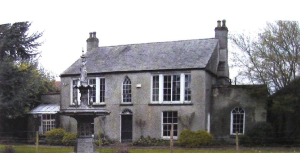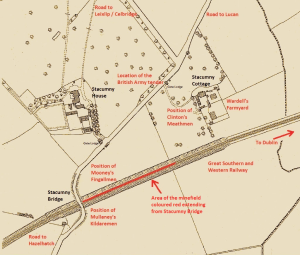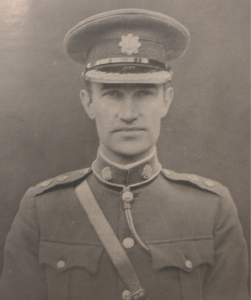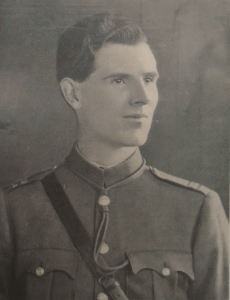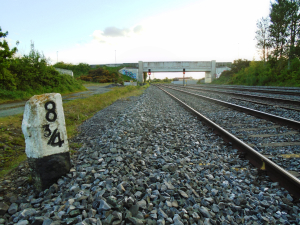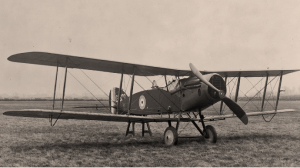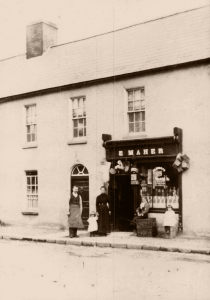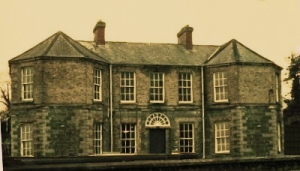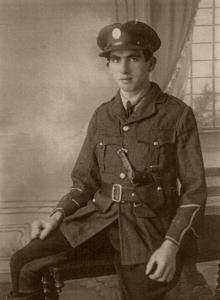The Stacumny Ambush
Celbridge, 2nd July 1921
Published in the Liffey Champion, 5th & 12th of June 2021
An attempt to ambush a British Army troop train at Stacumny near Celbridge in July 1921 was the biggest operation undertaken by the IRA in Country Kildare during the War of Independence. It occurred against the backdrop of a campaign promoted by the IRA General headquarters [GHQ] to hamper rail transportation of British troops in Ireland.
The opportunity arose in June 1921, when King George V opened the new parliament of Northern Ireland in Belfast. As it was during the most violent period of the War of Independence security for the visit was at an all-time high. Substantial numbers of soldiers were drafted into Belfast to provide safety for the visit with many of them transported from the garrison county of Kildare.
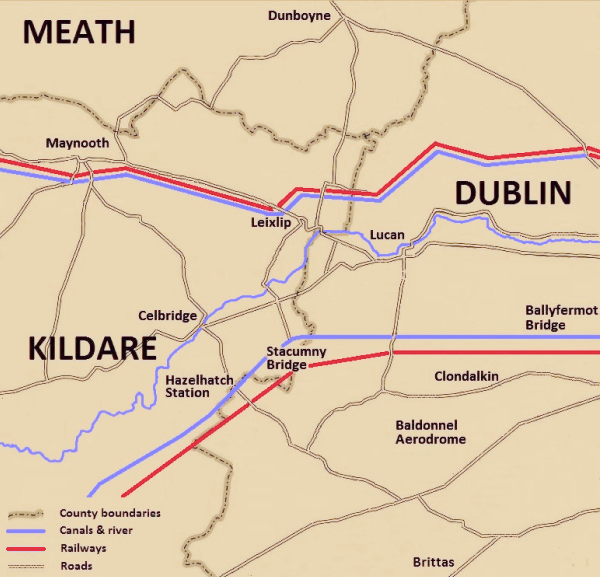
Map showing location of places mentioned and the bottleneck area.
Michael Collins, through his intelligence links, obtained details of the troop movements and more importantly the route and the time of their return journey. This presented IRA GHQ with an ideal opportunity to assault a number of troop trains on the return journey to Dublin and the Curragh. Plans were put in place to target the troop trains at four different locations on their return from Belfast. Richard Mulcahy IRA Chief of Staff pointed out the suitability of the north-eastern area of Kildare as a location. He argued that in the Dublin-Curragh region the Army have permanently quartered between one quarter and one third of their total armed strength in the country with all their lines of communication and transportation having to pass through what he referred to as ‘a narrow bottle-neck between Celbridge and Brittas’. Of the four trains targeted this area would be the most significant.
Adavoyle Railway Station
The first train attacked was carrying the 10th Hussars who had provided the escort for the King during the Belfast ceremonies. Three special trains had been commissioned to transport them to Dublin where they were scheduled to catch a Holyhead-bound ferry. On the 24th of June, the third train returning to Dublin was partially derailed by a mine and ambushed by the IRA’s Fourth Northern Division, led by Frank Aiken. The ambush took place near Adavoyle Railway Station, close to Jonesborough in South Armagh. The train in addition to members of the military carried the horses used by the cavalry. Three British soldiers were killed at the scene, with twenty wounded. A railway guard was also killed. There were also a substantial loss of horses with 51 either killed or having to be put down due the severity of their injuries.
Killester Bridge
At approximately the same time that the Adavoyle ambush was taking place one of the earlier trains carrying the 10th Hussars was targeted at Killester on its approach to Dublin. Paddy Daly was in charge with twenty men consisting of the Active Service Unit and members of the Squad. Mines were laid on the railway line close to Killester Bridge and one member of the party, Bill Stapleton, was armed with a Thompson machine gun on the bridge crossing the railway. The instructions were that the attack would begin when the Thompson gun first went into action. However, the plans had to be abandoned when one volunteer mistakenly fired a hand grenade at a local train that was passing prior to the arrival of the Belfast troop train.
Stacumny Ambush
The third assault was planned on the railway line in the bottle-neck area between Celbridge and Brittas. Two trains travelling together would be transporting a total of 950 soldiers to the Curragh on the 2nd of July and Michael Collins targeted the second train carrying 700 men who belonged to the King’s Own Yorkshire Light Infantry regiment. He personally chose the ambush site at Stacumny, which is situated three quarters of a mile from Young’s Cross just off the Celbridge to Lucan road. Collins also directed that a Thompson gun be provided for the operation.
Sean Boylan, O/C of the Eastern Division IRA was appointed in overall command of the operation. However, in planning the job with his divisional staff Boylan decided to engage in a full-scale ambush in addition to derailing the train in the hope of capturing a large quantity of arms and ammunition. Kildare activists had an important role in the initial preparations with Paddy Mullaney commandant in charge of the local North Kildare Battalion supervising the work. Between the 27th of June to the 2nd of July all available volunteers were busy mustering equipment which included tools for the proper laying of mines and other essentials in preparations for the ambush. This was carried out by Mullaney‘s transport officer Mick O’Neill from Weston. Men from three counties Meath, Fingal and Kildare were mobilised for the ambush. Sean Boylan wanted no more than 100 men to travel to the ambush site and meet up with 20 men from Kildare. This number did not include additional activists who assisted in a backup capacity. As the day of the ambush was a Saturday part-time activists as well as men on the run were available. Some of the men mobilised were from as far as Navan, Oldtown in north County Dublin and the Prosperous area of west Kildare. Matt Goff, who later obtained fame as an All-Ireland winning footballer, was one of the Leixlip men participating. On the night preceding the ambush the Meath and Fingal men assembled at Murtagh’s house close to Dunboyne where they were given a meal. A priest was also on hand in one of the rooms hearing confessions and this was availed of by most of the men.
While the principal members of the IRA Divisional Staff travelled to Stacumny, with instructions to look after their own operations, Sean Boylan was directed by Michael Collins to supervise as overall commander while remaining in Dunboyne.
In the dead of night under cover of darkness 100 men, many armed with Lee Enfield rifles and wearing bandoliers, made their way down Confey Hill and through Leixlip village undetected and headed for Stacumny.
Paddy Mullaney and the North Kildare men joined the main contingent outside Leixlip. Jimmy McGuinness who came from Dublin brought the Thompson machine-gun. The route taken by the Volunteers after Leixlip was by road to Cooldrinagh, Backweston and on to a farmhouse named Stacumny Cottage, which was owned by John Wardell. This residence was adjacent to the ambush site and was one of two houses taken over by the IRA. This task was given to Mullaney, the local commander and the occupants were held prisoner.
Many of the men were quartered in Stacumny Cottage and to amuse themselves while awaiting daybreak some even engaged in a singsong with one man attempting to provide background music on Wardell‘s piano.
In the morning the men were served with breakfast consisting of a hunk of loaf bread on which was a fried rasher and a mug of tea. The bulk of the men had come unarmed and after breakfast were called to a stable where they were each issued with a rifle and 25 rounds .303 ammunition. According to Mullaney, the buildings in the farmyard were utilized by the IRA with one big shed alone holding between 30 and 40 men. A number of employees worked on the farm and as they arrived for work in the morning, they were locked in the harness shed with the family. At 11am the local Celbridge postman R. W. Magan when delivering letters to the house was also imprisoned. Close to mid-day the principal IRA engineer, Eamon Cullen and his team began laying cables connected to explosives along the railway line extending from the bridge in the direction of Dublin. The entire minefield had to be buried under the train tracks. Meanwhile, Mullaney organised teams of his men to proceed to a number of locations where they felled trees to block roads in order to prevent reinforcements reaching the troops on the train when attacked.
Ambush Plan
The ambush plan was simple. Shortly before the expected arrival of the troop trains, due at 1am, various contingents of IRA who were concealed in Wardell’s farmyard were to take up positions on both sides of the track on either side of the bridge. Another party which included the engineers were to be positioned on the bridge. The pilot train which was to come first, would be allowed to proceed. The second train carrying 250 troops would also be allowed to pass. When the next train carrying 700 soldiers was passing, the minefield would be detonated by the engineers on the bridge which was expected to derail the entire train. The intention was to inflict as much damage on the last train by mines alone, so as the occupants would be incapable of putting up resistance. The men on the embankment on both sides of the railway line were to open fire at this point. Attempts would then be made to capture army rifles and ammunition from the troops on the derailed train. The IRA engineers accompanied, by McGuinness on the bridge, would be required to concentrate with rifle and machine gun fire on the first train in order to prevent any assistance being given by those soldiers to the derailed train.
Shortly before 1 o’clock, the Kildare men with Mullaney in charge left the farmyard and took up their positions on the south side of the railway line. Other units followed suit, but when the last and biggest contingent commanded by their section leader, Pat Clinton, was marching out of the farmyard to take up positions they were surprised by a passing British Army lorry which stopped on the road and an exchange of fire ensued. The military patrol consisted of a unit of the South Lancashire regiment who were based at Baldonnel Barracks. They had managed to patrol an area along Tandy’s Road from Lucan which had been left clear by the IRA to facilitate their getaway. The Army commenced firing and fire was returned by Clinton’s contingent who later described the noise as deafening, due mainly to the fact that behind them were galvanized sheds through which bullets were ripping and echoing at each shot.
While this section were tied down other contingents found themselves dangerously exposed although Mullaney was able to lead his men a short distance from the bank of the railway line in the direction of the canal before re-joining other section leaders, Eamon Cullen and Seamus Finn. At this point it was decided to make use of the Thompson gun and McGuinness moved to a position south of the railway and fired. Others from this party including Mullaney also fired with good results from a very open position on the Railway embankment. The sound of a machine gun firing caused confusion among the military to the extent that they temporarily ceased firing. Clinton’s section, who were pinned down, were able to take advantage of the diversion and made their escape. However, another mishap followed. As the troop train approached, an accompanying spotter airplane one of two that were part of the security precautions put in place by the military, spotted the danger and signalled to the train driver to stop within a short distance of the mine field. The IRA leaders, now realising that the operation was doomed to failure, ordered a general retreat, with every man for himself.
With the ambush at Stacumny Bridge aborted the challenge now facing the participants was to avoid capture and escape with their weapons and ammunition. The party including the leaders Cullen, Finn, Mullaney and McGuinness were like captains of a sinking ship as they were the last to leave. Despite the danger, Cullen went back to the bridge to retrieve the exploder as the instrument was very scarce. By this time the military were pouring from the train and extending across the country. An airplane was overhead and began to hover down on the four escaping men in an attempt to point out their position to the military. The group were lucky to have Mullaney as he knew the locality well. They made for a wood then kept close to ditches and shook off the airplane. However, they were not out of the woods yet. At one point they had to cross the main Lucan – Celbridge road and had to duck as lorries carrying Black and Tans passed. Mullaney leading the way brought them to Leixlip where they heard that other comrades had passed shortly before their arrival.
Many accounts survive of the pursuit of activists by the spotter planes. With 950 soldiers disembarking from two trains no shot could be fired at the planes which would pinpoint their location to the troops on the ground. One plane flew south to where the Kildare men were trying to get away, again using manoeuvres to pinpoint their location to British troops. Meanwhile, Paddy Mooney and the Fingal men who retreated along the railway line in the direction of Hazlehatch were also harassed by one of the airplanes. After traveling some distance they headed westward across country and waded through the Liffey under cover of the woods of Castletown Demesne before proceeding to Leixlip and on to Dunboyne. The Meath men were simultaneously pursued, with a plane swooping down on them several times and on occasions some had to throw themselves flat on the ground to avoid being rammed by it. A group of men used the position of the sun to determine a sense of direction and were able to continue their flight in a northerly direction eventually finding themselves on Lucan golf links. This is where the airplane made its last effort to harasses them as they scrambled behind a bunker. Proceeding to Leixlip they crossed the Liffey bridge which was unguarded and had to obtain directions for Dunboyne in order to reach open country again.
The skilful aerial manoeuvres by RAF pilots following the ambush are partly reminiscent of aerial dogfights that took place during the shooting of the Blue Max, a World War 1 film in 1965, which by coincidence was shot on location close to Stacumny in Baldonnel and Weston Aerodromes.
Back-up and Injured Man
For the retreating IRA activists there was some degree of backup assistance in place on the Leixlip – Dunboyne road. This included the car and driver that was available for use of the IRA divisional staff. Stacumny is only six miles as the crow flies from Dunboyne and it was obvious that something went wrong as no explosion was heard. One member of the backup team was Nan Murtagh who lived in the farmhouse where the temporary IRA H/Q was established. She cycled from Dunboyne towards Leixlip and as she came across the various parties fleeing from the scene, provided them with assistance and directions. The divisional driver in the meantime returned to the rural area between Leixlip and Dunboyne to pick up more men fleeing from the ambush scene. The only casualty on the IRA side was a volunteer from Summerhill who broke his leg while jumping a ditch in the retreat. Initially he had to be carried in relays by his comrades. In Leixlip he was assisted by a local activist Nelly Dillon. Nan Murtagh came to the rescue again, she got hold of a pony and trap and with the aid of her young brother brought first aid outfits and a stretcher. Eventually, he was safely brought back to his home in Summerhill. In Kildare local men provided a line of retreat for men and back up assistance from the following companies, Leixlip, Celbridge, Straffan, Mainham and Prosperous. All the Volunteers, including the Meath men, the Fingal men and the Kildare men made it safely back to their native areas despite the heavy military presence. Amazingly, there were no other casualties despite heavy gunfire, the only fatality was a horse close to Wardell’s farmyard that was killed in the crossfire.
Reprisal
Although the Black and Tans and Auxiliaries were notorious in carrying out reprisals following IRA attacks, no serious retaliation took place following the Stacumny encounter. However, Black and Tans from Lucan rounded up six men from Leixlip including local man Edward Maher, who were taken to Stacumny and compelled to walk at gunpoint on the railway tracks for a number of miles south west in the direction of Straffan. The Tans were of the belief that there were other explosives on the line and used the local men as human shields. The people compelled to walk on the railway were terrified expecting to be blown up from stepping on a mine.
Assault on Lucan Barracks
When the ambush leaders returned to Leixlip, Mullaney persuaded McGuinness to lend him the Thompson gun until the next day. His initial plan was to avail of the gun in ambushing a Black and Tan tender on the Lucan – Leixlip road, however, no suitable opportunity arose. Not disheartened Mullaney turned his attention to Lucan RIC barracks, a simple assault could hamper follow-up searches and to some extent pin down Black and Tans who may be planning night-time reprisals. Shortly after 12 midnight on Monday morning the 3th of July, Mullaney and his men positioned inside the wall of Lucan Demesne, assaulted the barracks on the opposite side of the road with Thompson gun and rifle fire. According to Mullaney, Mick O’Neill was his ‘Thompson gunner’ on this occasion. The attackers maintained that they were able to engage from a position as close as 15 yards from the barracks. One of the RIC officers in the barrack, Sergeant Michael Lynch describes the scene:
Rifle and machine gun fire were opened on the barracks at about 12.30am. The firing continued for considerably more than half an hour, practically all the windows in the barracks were shattered; it was not possible to estimate the number of attackers, but judging from the amount of broken glass in the interior of the building and the number of rifle and machine gun shells fired in the vicinity, [which were discovered] on the following morning, we concluded there were a considerable number of attackers. The firing was continually replied to from inside and verey lights [flare signals] were sent up for reinforcements.
This engagement certainly took the pressure off local IRA activists in the aftermath of the Stacumny Ambush. Black and Tans could be fearless in tackling a unit armed with shotguns and home-made cartridges, however, tackling a unit with a machine gun would suggest a more restrained and cautious approach by the Tans. It was obvious, Mullaney wanted the Tans to believe that the local unit had a Thompson gun and were prepared to use it.
Retrieving hidden guns
In the days following the ambush a dangerous operation was undertaken to retrieve guns and ammunition hidden by IRA as they were fleeing the scene. Two of the Meath men that hid the arms returned to Stacumny and were able to retrace their steps, finding the rifles and ammunition where they had left them. They noticed that the hay-cocks that they at one stage had used for cover and the hedges in the vicinity of the house had been burned. Apparently, the military suspected that arms were concealed in the hay. The pilot in the airplane in his pursuit of the men noticed that they were armed in the hay field but had disposed of their arms by the time they had got to Lucan golf links.
The Final Assault, Ballyfermot Bridge Ambush
Despite the failure of the Stacumny ambush, planned attacks on troop trains continued and on the 8th of July the Active Service Unit in Dublin ambushed a troop train at Ballyfermot Bridge which is situated only five miles from Stacumny. They were armed with bombs and revolvers and under the command of Padraig O’Connor who had been raised in Celbridge. Jimmy McGuinness was also on hand with the Thompson gun. Surprisingly on this occasion army security was not as intensive as at Stacumny and McGuinness was able to fire the Thompson gun from the parapet of the bridge. As the train passed under the bridge, petrol from a drum was poured down and a sack soaked in petrol was thrown on top of it. Despite this the train continued to Clondalkin train station where it stopped for a short time. No details regarding casualties or extent of injuries were given by the military although it is known that one civilian in the train died from injuries sustained in the attack. The troops on the train belonged to an advance party of the 2nd Gordon Highlanders.
This was the fourth occasion that troop trains had been targeted by the IRA and the army at this point suspended transportation of troops by rail. The main body of the 2nd Gordon Highlanders had to travel by march route and they arrived at the Curragh two days later on the 10th July. A simple exercise of moving soldiers safely from Belfast to Dublin and through County Kildare to the Curragh had now become a journey through a war zone. The truce which ended hostilities came into force on the following day.
The attempted ambush at Stacumny was the biggest and most daring operation carried out by the IRA in Kildare during the War of Independence. It was the only incident in which shots were fired at regular British soldiers in the county. Although it ended in failure there was a successful conclusion to the general IRA operation of targeting troop trains. The Irish Munitions Strike from May to December 1920 when railwaymen refused to operate trains carrying munitions of war or armed military personnel, ended in failure. Yet IRA operations targeting troop trains between the 24th of June and the 8th of July 1921, led to the temporary suspension of the transportation of troops by rail. The success of this military operation and assessment of the level of hardship inflicted on the British army cannot be realistically assessed due to the truce coming into effect three days after the suspension. While the truce was a relief for IRA activists, it was also a relief for the British army who were able to resume transportation of troops by rail in late July but having to strictly adhere to truce terms which forbade troop reinforcements.
Sources
- Hugh Jeudwine, ‘History of the 5th Division in Ireland, November 1919 – March 1922’, (Imperial War Museum London, Jeudwine papers, 72/82/2).
- Compensation Ireland commission Kildare, 1919–1922 (National Archives London, CO 905/7/281).
- Paddy Mullaney interview (UCD Archives, O’Malley notebooks, P17b/106,110).
- Sean Boylan (Irish Military Archives [IMA], BMH WS 1715).
- Paddy Daly (IMA, BMH WS 387).
- Patrick McCrea (IMA, BMH WS WS 413).
- Matthew Barry (IMA, BMH WS WS 932).
- John Gaynor (IMA, BMH WS 1447).
- Seamus Finn (IMA, BMH WS 1060).
- Joe McGuinness (IMA, BMH WS 607).
- Nelly Dillon (IMA, MSP34REF7).
- Engagement at Stacumny (IMA, Brigade activity reports).
- Freemans Journal, 26 June 1921.
- Kildare Observer, 9 July 1921.
- Lillian Olive Wardell, History of Stacumny (2000), p. 11 (Celbridge Library, unpublished).
- Oliver Coogan, War and Politics in Meath, (Dunshaughlin, 1983) pp 182–4.
- Michael Hopkinson, The Irish War of Independence, (Dublin, 2002), pp 102–3.
- Diarmuid O’Connor and Frank Connolly, Sleep soldier sleep: The life and times of Padraig O’Connor (Dublin, 2011), pp 58–60.
- Seamus Cullen, Kildare: the Irish Revolution, 1912–23 (Dublin, 2020), pp 86, 92.
- Personal communication, Tom McHugh, 1992; Tony Maher, 2010.

